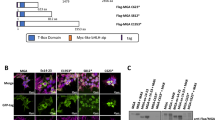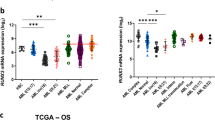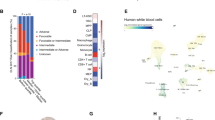Abstract
The t(12;21)(p13;q22) translocation generates the TEL-AML1 (TEL, translocation-Ets-leukemia; AML1, acute myeloid leukemia-1) (ETV6-RUNX1) fusion product and is the most common chromosomal abnormality in pediatric leukemia. Our previous studies using a murine fetal liver transplantation model demonstrated that TEL-AML1 promotes the self-renewal of B-cell precursors in vitro and enhances the expansion of hematopoietic stem cells (HSCs) in vivo. This is consistent with the hypothesis that TEL-AML1 induces expansion of a preleukemic clone. Several studies have described domains within TEL-AML1 involved in the transcriptional regulation of specific target genes. However, it is unclear which of these domains is important for the activity of TEL-AML1 in preleukemic hematopoiesis. In order to examine this, we have generated a panel of deletion mutants and expressed them in HSCs. These experiments demonstrate that TEL-AML1 requires multiple domains from both TEL and AML1 to alter hematopoiesis. Furthermore, mutation of a single amino-acid residue within the runt homology domain of AML1, required for DNA binding, was sufficient to abrogate TEL-AML1 activity. These data suggest that TEL-AML1 acts as an aberrant transcription factor to perturb multiple pathways during hematopoiesis.
This is a preview of subscription content, access via your institution
Access options
Subscribe to this journal
Receive 50 print issues and online access
$259.00 per year
only $5.18 per issue
Buy this article
- Purchase on Springer Link
- Instant access to full article PDF
Prices may be subject to local taxes which are calculated during checkout







Similar content being viewed by others
References
Andreasson P, Schwaller J, Anastasiadou E, Aster J, Gilliland DG . (2001). The expression of ETV6/CBFA2 (TEL/AML1) is not sufficient for the transformation of hematopoietic cell lines in vitro or the induction of hematologic disease in vivo. Cancer Genet Cytogenet 130: 93–104.
Aronson BD, Fisher AL, Blechman K, Caudy M, Gergen JP . (1997). Groucho-dependent and -independent repression activities of Runt domain proteins. Mol Cell Biol 17: 5581–5587.
Bernardin F, Yang Y, Cleaves R, Zahurak M, Cheng L, Civin CI et al. (2002). TEL-AML1, expressed from t(12;21) in human acute lymphocytic leukemia, induces acute leukemia in mice. Cancer Res 62: 3904–3908.
Bruhn L, Munnerlyn A, Grosschedl R . (1997). ALY, a context-dependent coactivator of LEF-1 and AML-1, is required for TCRalpha enhancer function. Genes Dev 11: 640–653.
Busson-Le Coniat M, Nguyen Khac F, Daniel MT, Bernard OA, Berger R . (2001). Chromosome 21 abnormalities with AML1 amplification in acute lymphoblastic leukemia. Genes Chromosomes Cancer 32: 244–249.
Cameron ER, Neil JC . (2004). The Runx genes: lineage-specific oncogenes and tumor suppressors. Oncogene 23: 4308–4314.
Dal Cin P, Atkins L, Ford C, Ariyanayagam S, Armstrong SA, George R et al. (2001). Amplification of AML1 in childhood acute lymphoblastic leukemias. Genes Chromosomes Cancer 30: 407–409.
Durst KL, Hiebert SW . (2004). Role of RUNX family members in transcriptional repression and gene silencing. Oncogene 23: 4220–4224.
Fears S, Gavin M, Zhang DE, Hetherington C, Ben-David Y, Rowley JD et al. (1997). Functional characterization of ETV6 and ETV6/CBFA2 in the regulation of the MCSFR proximal promoter. Proc Natl Acad Sci USA 94: 1949–1954.
Fenrick R, Amann JM, Lutterbach B, Wang L, Westendorf JJ, Downing JR et al. (1999). Both TEL and AML-1 contribute repression domains to the t(12;21) fusion protein. Mol Cell Biol 19: 6566–6574.
Fischer M, Schwieger M, Horn S, Niebuhr B, Ford A, Roscher S et al. (2005). Defining the oncogenic function of the TEL/AML1 (ETV6/RUNX1) fusion protein in a mouse model. Oncogene 24: 7579–7591.
Golub TR, Barker GF, Bohlander SK, Hiebert SW, Ward DC, Bray-Ward P et al. (1995). Fusion of the TEL gene on 12p13 to the AML1 gene on 21q22 in acute lymphoblastic leukemia. Proc Natl Acad Sci USA 92: 4917–4921.
Greaves MF, Maia AT, Wiemels JL, Ford AM . (2003). Leukemia in twins: lessons in natural history. Blood 102: 2321–2333.
Growney JD, Shigematsu H, Li Z, Lee BH, Adelsperger J, Rowan R et al. (2005). Loss of Runx1 perturbs adult hematopoiesis and is associated with a myeloproliferative phenotype. Blood 106: 494–504.
Guidez F, Petrie K, Ford AM, Lu H, Bennett CA, MacGregor A et al. (2000). Recruitment of the nuclear receptor corepressor N-CoR by the TEL moiety of the childhood leukemia-associated TEL-AML1 oncoprotein. Blood 96: 2557–2561.
Gunji H, Waga K, Nakamura F, Maki K, Sasaki K, Nakamura Y et al. (2004). TEL/AML1 shows dominant-negative effects over TEL as well as AML1. Biochem Biophys Res Commun 322: 623–630.
Hiebert SW, Sun W, Davis JN, Golub T, Shurtleff S, Buijs A et al. (1996). The t(12;21) translocation converts AML-1B from an activator to a repressor of transcription. Mol Cell Biol 16: 1349–1355.
Ichikawa M, Asai T, Saito T, Seo S, Yamazaki I, Yamagata T et al. (2004). AML-1 is required for megakaryocytic maturation and lymphocytic differentiation, but not for maintenance of hematopoietic stem cells in adult hematopoiesis. Nat Med 10: 299–304.
Imai Y, Kurokawa M, Tanaka K, Friedman AD, Ogawa S, Mitani K et al. (1998). TLE, the human homolog of groucho, interacts with AML1 and acts as a repressor of AML1-induced transactivation. Biochem Biophys Res Commun 252: 582–589.
Javed A, Guo B, Hiebert S, Choi JY, Green J, Zhao SC et al. (2000). Groucho/TLE/R-esp proteins associate with the nuclear matrix and repress RUNX (CBF(alpha)/AML/PEBP2(alpha)) dependent activation of tissue-specific gene transcription. J Cell Sci 113 (Part 12): 2221–2231.
Kim DH, Moldwin RL, Vignon C, Bohlander SK, Suto Y, Giordano L et al. (1996). TEL-AML1 translocations with TEL and CDKN2 inactivation in acute lymphoblastic leukemia cell lines. Blood 88: 785–794.
Kitabayashi I, Yokoyama A, Shimizu K, Ohki M . (1998). Interaction and functional cooperation of the leukemia-associated factors AML1 and p300 in myeloid cell differentiation. EMBO J 17: 2994–3004.
Li Z, Yan J, Matheny CJ, Corpora T, Bravo J, Warren AJ et al. (2003). Energetic contribution of residues in the Runx1 Runt domain to DNA binding. J Biol Chem 278: 33088–33096.
Lopez RG, Carron C, Oury C, Gardellin P, Bernard O, Ghysdael J . (1999). TEL is a sequence-specific transcriptional repressor. J Biol Chem 274: 30132–30138.
Lorsbach RB, Moore J, Ang SO, Sun W, Lenny N, Downing JR . (2004). Role of RUNX1 in adult hematopoiesis: analysis of RUNX1-IRES-GFP knock-in mice reveals differential lineage expression. Blood 103: 2522–2529.
Lutterbach B, Hiebert SW . (2000). Role of the transcription factor AML-1 in acute leukemia and hematopoietic differentiation. Gene 245: 223–235.
Lutterbach B, Westendorf JJ, Linggi B, Isaac S, Seto E, Hiebert SW . (2000). A mechanism of repression by acute myeloid leukemia-1, the target of multiple chromosomal translocations in acute leukemia. J Biol Chem 275: 651–656.
McLean TW, Ringold S, Neuberg D, Stegmaier K, Tantravahi R, Ritz J et al. (1996). TEL/AML-1 dimerizes and is associated with a favorable outcome in childhood acute lymphoblastic leukemia. Blood 88: 4252–4258.
Meyers S, Lenny N, Hiebert SW . (1995). The t(8;21) fusion protein interferes with AML-1B-dependent transcriptional activation. Mol Cell Biol 15: 1974–1982.
Mikhail FM, Serry KA, Hatem N, Mourad ZI, Farawela HM, El Kaffash DM et al. (2002). AML1 gene over-expression in childhood acute lymphoblastic leukemia. Leukemia 16: 658–668.
Mori H, Colman SM, Xiao Z, Ford AM, Healy LE, Donaldson C et al. (2002). Chromosome translocations and covert leukemic clones are generated during normal fetal development. Proc Natl Acad Sci USA 99: 8242–8247.
Morrow M, Horton S, Kioussis D, Brady HJ, Williams O . (2004). TEL-AML1 promotes development of specific hematopoietic lineages consistent with preleukemic activity. Blood 103: 3890–3896.
Niini T, Kanerva J, Vettenranta K, Saarinen-Pihkala UM, Knuutila S . (2000). AML1 gene amplification: a novel finding in childhood acute lymphoblastic leukemia. Haematologica 85: 362–366.
Okuda T, van Deursen J, Hiebert SW, Grosveld G, Downing JR . (1996). AML1, the target of multiple chromosomal translocations in human leukemia, is essential for normal fetal liver hematopoiesis. Cell 84: 321–330.
Osato M, Asou N, Abdalla E, Hoshino K, Yamasaki H, Okubo T et al. (1999). Biallelic and heterozygous point mutations in the runt domain of the AML1/PEBP2alphaB gene associated with myeloblastic leukemias. Blood 93: 1817–1824.
Otto F, Kanegane H, Mundlos S . (2002). Mutations in the RUNX2 gene in patients with cleidocranial dysplasia. Hum Mutat 19: 209–216.
Poirel H, Lacronique V, Mauchauffe M, Le Coniat M, Raffoux E, Daniel MT et al. (1998). Analysis of TEL proteins in human leukemias. Oncogene 16: 2895–2903.
Preudhomme C, Warot-Loze D, Roumier C, Grardel-Duflos N, Garand R, Lai JL et al. (2000). High incidence of biallelic point mutations in the Runt domain of the AML1/PEBP2 alpha B gene in Mo acute myeloid leukemia and in myeloid malignancies with acquired trisomy 21. Blood 96: 2862–2869.
Quack I, Vonderstrass B, Stock M, Aylsworth AS, Becker A, Brueton L et al. (1999). Mutation analysis of core binding factor A1 in patients with cleidocranial dysplasia. Am J Hum Genet 65: 1268–1278.
Raynaud S, Cave H, Baens M, Bastard C, Cacheux V, Grosgeorge J et al. (1996). The 12;21 translocation involving TEL and deletion of the other TEL allele: two frequently associated alterations found in childhood acute lymphoblastic leukemia. Blood 87: 2891–2899.
Rho JK, Kim JH, Yu J, Choe SY . (2002). Correlation between cellular localization of TEL/AML1 fusion protein and repression of AML1-mediated transactivation of CR1 gene. Biochem Biophys Res Commun 297: 91–95.
Romana SP, Mauchauffe M, Le Coniat M, Chumakov I, Le Paslier D, Berger R et al. (1995). The t(12;21) of acute lymphoblastic leukemia results in a tel-AML1 gene fusion. Blood 85: 3662–3670.
Scandura JM, Boccuni P, Cammenga J, Nimer SD . (2002). Transcription factor fusions in acute leukemia: variations on a theme. Oncogene 21: 3422–3444.
Shurtleff SA, Buijs A, Behm FG, Rubnitz JE, Raimondi SC, Hancock ML et al. (1995). TEL/AML1 fusion resulting from a cryptic t(12;21) is the most common genetic lesion in pediatric ALL and defines a subgroup of patients with an excellent prognosis. Leukemia 9: 1985–1989.
Song WJ, Sullivan MG, Legare RD, Hutchings S, Tan X, Kufrin D et al. (1999). Haploinsufficiency of CBFA2 causes familial thrombocytopenia with propensity to develop acute myelogenous leukaemia. Nat Genet 23: 166–175.
Sun W, Downing JR . (2004). Haploinsufficiency of AML1 results in a decrease in the number of LTR-HSCs while simultaneously inducing an increase in more mature progenitors. Blood 104: 3565–3572.
Tsuzuki S, Seto M, Greaves M, Enver T . (2004). Modeling first-hit functions of the t(12;21) TEL-AML1 translocation in mice. Proc Natl Acad Sci USA 101: 8443–8448.
Uchida H, Downing JR, Miyazaki Y, Frank R, Zhang J, Nimer SD . (1999). Three distinct domains in TEL-AML1 are required for transcriptional repression of the IL-3 promoter. Oncogene 18: 1015–1022.
Wang L, Hiebert SW . (2001). TEL contacts multiple co-repressors and specifically associates with histone deacetylase-3. Oncogene 20: 3716–3725.
Wang LC, Kuo F, Fujiwara Y, Gilliland DG, Golub TR, Orkin SH . (1997). Yolk sac angiogenic defect and intra-embryonic apoptosis in mice lacking the Ets-related factor TEL. EMBO J 16: 4374–4383.
Wang LC, Swat W, Fujiwara Y, Davidson L, Visvader J, Kuo F et al. (1998). The TEL/ETV6 gene is required specifically for hematopoiesis in the bone marrow. Genes Dev 12: 2392–2402.
Wang Q, Stacy T, Binder M, Marin-Padilla M, Sharpe AH, Speck NA . (1996). Disruption of the Cbfa2 gene causes necrosis and hemorrhaging in the central nervous system and blocks definitive hematopoiesis. Proc Natl Acad Sci USA 93: 3444–3449.
Wiemels JL, Ford AM, Van Wering ER, Postma A, Greaves M . (1999). Protracted and variable latency of acute lymphoblastic leukemia after TEL-AML1 gene fusion in utero. Blood 94: 1057–1062.
Yoshida T, Kanegane H, Osato M, Yanagida M, Miyawaki T, Ito Y et al. (2002). Functional analysis of RUNX2 mutations in Japanese patients with cleidocranial dysplasia demonstrates novel genotype–phenotype correlations. Am J Hum Genet 71: 724–738.
Zeng C, McNeil S, Pockwinse S, Nickerson J, Shopland L, Lawrence JB et al. (1998). Intranuclear targeting of AML/CBFalpha regulatory factors to nuclear matrix-associated transcriptional domains. Proc Natl Acad Sci USA 95: 1585–1589.
Zeng C, van Wijnen AJ, Stein JL, Meyers S, Sun W, Shopland L et al. (1997). Identification of a nuclear matrix targeting signal in the leukemia and bone-related AML/CBF-alpha transcription factors. Proc Natl Acad Sci USA 94: 6746–6751.
Zhou G, Chen Y, Zhou L, Thirunavukkarasu K, Hecht J, Chitayat D et al. (1999). CBFA1 mutation analysis and functional correlation with phenotypic variability in cleidocranial dysplasia. Hum Mol Genet 8: 2311–2316.
Acknowledgements
We thank Sarah Horton, Rebecca Randall and Jasper de Boer (Institute of Child Health) for their help and support, Nancy Speck and Matthew Cheney (Dartmouth Medical School) for their advice on AML1 point mutations and Ewan Cameron (University of Glasgow Veterinary School) and Shai Izraeli (Sheba Medical Center) for useful discussions about our work. This work was supported by funding from the Leukaemia Research Fund and Children With Leukaemia, UK.
Author information
Authors and Affiliations
Corresponding author
Additional information
Supplementary Information accompanies the paper on the Oncogene website (http://www.nature.com/onc).
Supplementary information
Rights and permissions
About this article
Cite this article
Morrow, M., Samanta, A., Kioussis, D. et al. TEL-AML1 preleukemic activity requires the DNA binding domain of AML1 and the dimerization and corepressor binding domains of TEL. Oncogene 26, 4404–4414 (2007). https://doi.org/10.1038/sj.onc.1210227
Received:
Revised:
Accepted:
Published:
Issue Date:
DOI: https://doi.org/10.1038/sj.onc.1210227
Keywords
This article is cited by
-
Regulome analysis in B-acute lymphoblastic leukemia exposes Core Binding Factor addiction as a therapeutic vulnerability
Nature Communications (2022)
-
Molecular processes involved in B cell acute lymphoblastic leukaemia
Cellular and Molecular Life Sciences (2018)
-
RUNX1/ETO blocks selectin-mediated adhesion via epigenetic silencing of PSGL-1
Oncogenesis (2015)
-
Blocking ETV6/RUNX1-induced MDM2 overexpression by Nutlin-3 reactivates p53 signaling in childhood leukemia
Leukemia (2014)
-
B-lineage transcription factors and cooperating gene lesions required for leukemia development
Leukemia (2013)



